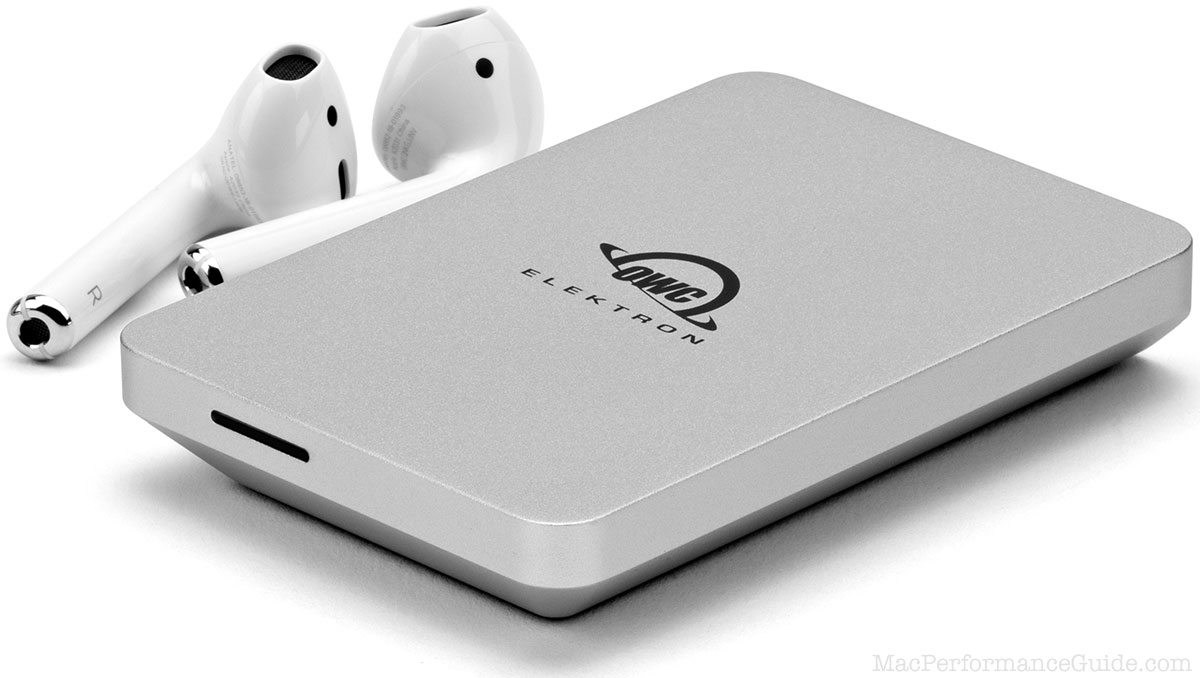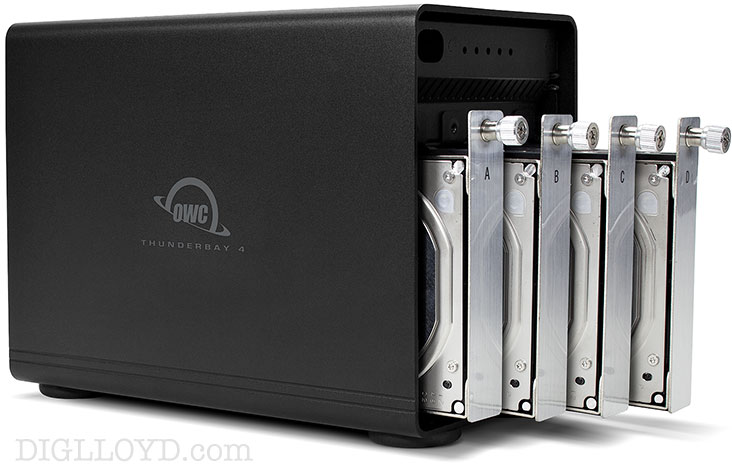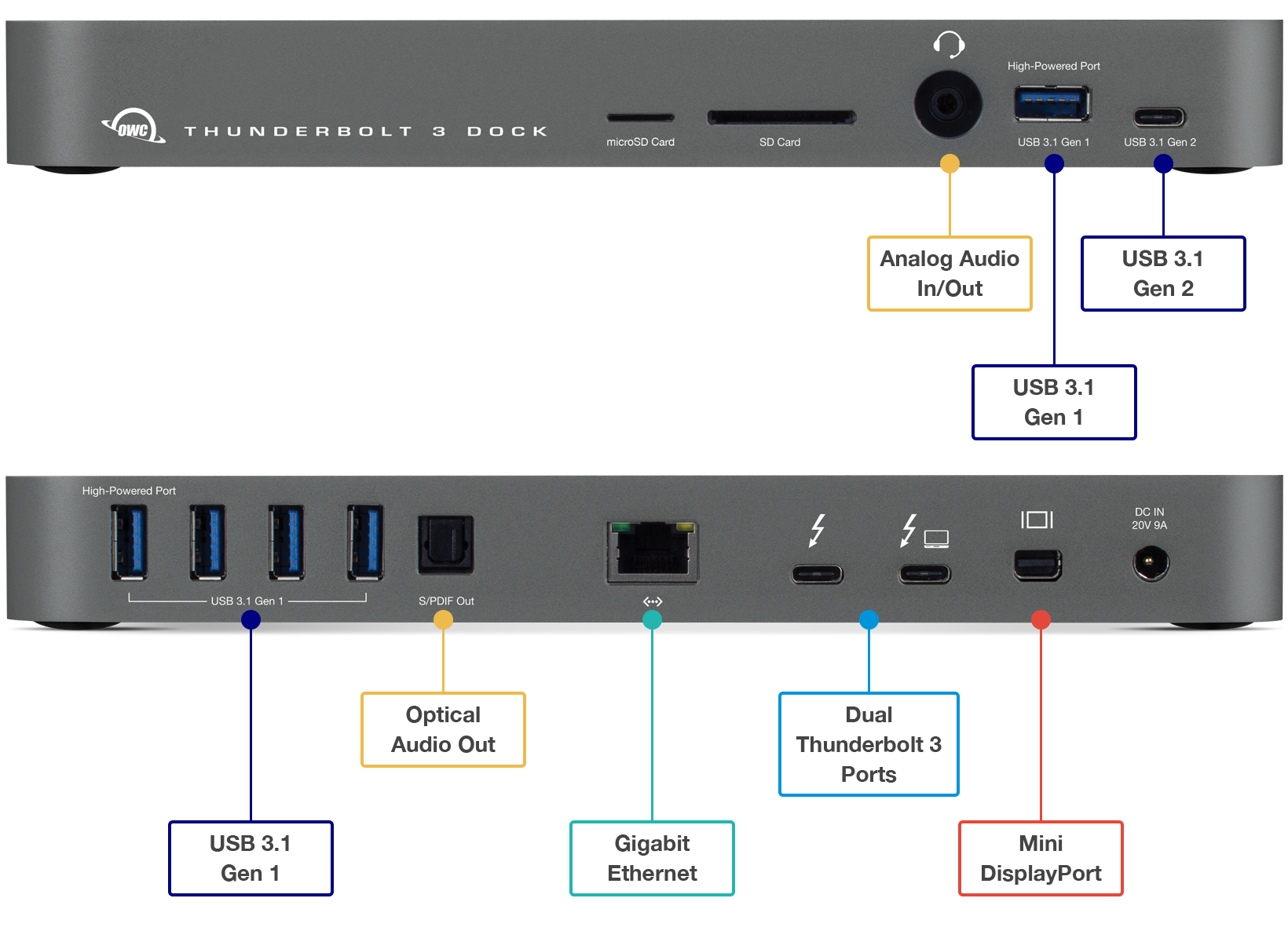
$220 SAVE $130 = 37.0% Western Digital 16.0TB Western Digital Ultrastar DC HC550 3.5-in… in Storage: Hard Drives
|

|

|

|

|
Concussion: Post-Crash Recovery Phase 2, Mid-way Phase
Related: acclimatizing to altitude, concussion, cycling, exercise, health, Mercedes Sprinter, noise, peak bagging, road biking, tDCS
Legal disclaimer: Since we are not doctors, never follow anything based on health-related topics on this or related sites without first consulting with your doctor or other trusted health professional. OTOH, the study of brain injuries is at best in its infancy, like studying outer space with primitive telescopes.
This page contains observations during the post-acute phase. During this period and as with the acute phase, I had little tolerance for exercise, and computer work became a strain after 30-45 minutes.
Thank you to supportive readers, and especially my loyal subscribers. The latter are critically important to me as I recover, and I am grateful to them. I also want to thank OWC / MacSales.com and B&H Photo for their ongoing support as I work through this.
Continues in Concussion Recovery Phase 3.
Update April 10, 25 days after crash, 20 days after ER visit #2
See my newly-added nutrition page, which is not complete, but a good start.
April 10 is continued in Recovery Phase 3, as it turned out to be a breakthrough day. Below, the morning’s entry.
...
Breakfast: 2 cups raw spinach, 1/2 pint blueberries, large tangerine, small avocado, cherry tomatoes, (yuck, a mistake) potato chips, 36g Hammer whey protein isolate, 2100g Omega 3 from Nordic Naturals @AMAZON, 500mg turmeric extract from Nature’s Way Turmeric @AMAZON,
Neuroplasticity is an area of increasing research, and has already been proven to reverse crippling brain injuries. But it has yet to become mainstream.
A few readers have in effect suggested that we (I) should accept things as they are. I do not. Man adapts the environment to himself, not the other way around. So why accept the idea that brain function is cast in stone? The mere acceptance means the doom of having it be so. So why seek out ways to stimulate the brain and improve function? It is well proven that even very old brains retain a high degree of neuroplasticity. Moreover, via self observation, I am certain that wiring changes have already occurred as the result of my concussion (see my pain banishment notes as well as the joy/mindfulness discussion in previous days). As well, my neuromuscular coordination seems to be as good as ever—might the Halo Sport @AMAZON (more on that below) have played a role?
I am not going to accept the idea that my concussion will leave me with cognitive impairments of any kind. Rather, I see this as a new challenge in exploring both tDCS and PoNS, whether or not I end up with cognitive impairments: I want to be better than before, just as good is no longer my goal. The question is how to try it out. It will take some months of study, but it is now on my high priority list for the long long term.
tDCS
I forgot to discuss this in prior entries, but before the concussion and after as well, I am convinced that the Halo Sport @AMAZON is beneficial. It might explain why my neuromuscular coordination seems to be intact post-concussion (I’ve been using it most days and I have never felt so fluid on my bike nor had the endurance all the way to 200 miles without low spots until 2018, when I started using it).
The Halo Sport @AMAZON uses Bihemispheric Transcranial Direct Current Stimulation (tDCS). See the science/research basis for tDCS. It is my suspicion that it might aid in other ways, but as yet that is unproven.
(tES) has emerged as a useful technique in clinical neuroscience due to its ability to modulate corticospinal excitability and induce neuroplasticity in motor and other cortical regions. Several tES strategies aimed at modifying cortical excitability have been developed and frequently practiced over this time. Two such promising techniques are transcranial direct cur- rent stimulation (tDCS) and transcranial variable frequency stimulation (tVFS).
Transcranial direct current stimulation (tDCS) involves the application of a weak electrical current via two surface electrodes, an anode and a cathode. Animal studies (Jaberzadeh et al. 2013) and modeling work (Radman et al. 2009) suggest that anodal stimulation depolarizes excitatory neurons by increasing the resting membrane potential and hyperpolarizes inhibitory neurons by decreasing the resting membrane potential, while cathodal stimulation has the opposite effect. Thus, anodal tDCS is believed to generally in- crease cortical excitability while cathodal tDCS is believed to generally decrease it.
These changes can last for hours or days after application of tDCS (Waters- Metenier et al. 2014). Studies on electrode placement indicate that modulatory effects are somewhat focal, allowing for effective stimulation of distinct brain regions. For example, multiple studies have found that tDCS over the primary motor cortex (M1) can produce long-lasting effects on motor learning (Waters- Metenier et al. 2014). Other studies have shown that tDCS over the dorsolateral prefrontal cortex (DLPFC) can produce long-term improvements in memory and cognitive function (Fregni et al. 2005).
Ultra-high performance across entire capacity, outperforms the competition.
Tiny, bus-powered, rugged, compact!
PoNS
Of great interest to me is PoNs—the stimulation of the brain via the tongue, which is wired directly into the brain stem, and thus any electrical signals via the tongue go just about everywhere. Read more about PoNS. For example, from Helios Medical Technologies in The Portable Neuromodulation Stimulator (PoNSTM) FACT SHEET:
How Does the PoNSTM device work? In the research setting, the PoNS device delivers specially-patterned electrical stimulation developed to mirror nerve impulses to the brain through 143-gold-plated electrodes on the mouthpiece which is placed on the tongue. For 20 minutes the electrical stimulation is coupled with targeted functional therapy, called Cranial Nerve Non-Invasive Neuromodulation (CN-NINM).
Therapy consists of condition-specific physical, occupational, relaxation and cognitive exercises, based on the patient's deficits. Clinical research shows that electrical stimulation of the tongue activates two major cranial nerves – the lingual nerve (part of the trigeminal nerve) and the chorda tympani (part of the facial nerve). Electrical stimulation of the cranial nerves creates a flow of neural impulses that are then delivered directly into the brain stem and cerebellum – the main control centers for many life functions including sensory perception and movement. From the brain stem, these impulses travel throughout the brain and activate or reactivate neurons and structures involved in human function – the cortex, spinal cord and potentially the entire central nervous system. How does this happen? Researchers believe that sustained stimulation initiates a sequential cascade of changes in the actual interconnected nuclei, or neuronal network, the fundamental connections between the anatomical components of the brain.3
Update April 9, 24 days after crash, 19 days after ER visit #2
It is now my conclusion that some brain rewiring is going on, for the good, things I explained in previous days. What else might be happening that is good or bad? I am making self observation an integrated part of the day, all day. What is not clear is what if anything will be at a deficit (bad) a month from now. I sense no cognitive impairment , but then again I have not tried to do any calculus as yet.
To bed at 8:30 PM last night and that along with a good night's sleep (with its usual 2 or 3 awakenings) was about as good as I could hope for. I deliberately did not rise early, lazing about till 8 AM or so. An early 1 hour 45 minute ride at ~6800' elevation at about 10:30 AM felt terrific, indeed ALL rides have felt good, seemingly normal and I feel very upbeat doing them and I think they are very helpful for recovery, just from my overall sense of well being. Still, there seems to be a limit of 2 hours or less that is optimal and a big “but”: with this moderately vigorous ride done, I felt the need for sleep, which turned into nearly 3 hours!
Today I had a bad (good) case of “sewing machine leg”. Athletes might know this as the excess energy that when well rested that makes the muscles want to move hence the leg (or both) pump up and down via the foot/ankle as fast as 7-10 times per seconds. In all my life, I deem this GOOD as it means physically that things are rested and ready to go.
Clearly, while exercise feels good, it makes some kind of demand on the brain that only sleep cures—muscles not tired at all. I have these sense of increasing effort, not in the muscles, but mentally, past 80 minutes or so. But with the ride and nap done, I felt very good the rest of the day and into evening (8:43 PM), which is a FIRST. So I have to at least say that biking is not hurting and sure looks like it is helping. Increase blood flows speeds many types of healing and releases feel-good chemicals.
One of my initial concerns was that altitude would be an issue but being well acclimatized to ~7000 feet now (as determined by objective data while riding as well as subjective feel and HR/breathing), I seem to have no ill effects. Clearly the response to hypoxia has increased red blood cell volume in blood plasma as it ought, as riding up to 7600' has been no issue at all, and feels terrific.
My general observation is that endurance/stamina (mental/physical) is a fraction of what it was pre-concussion, though I can now tolerate 1 to 2 hours of exercise, 2-3 hours of driving, and 30 minutes or less of loud noise. Computer work perhaps 2 hours at most.
Of particular note is that I see no discernible effects on muscular strength or coordination or balance, a curious and frustrating bifurcation, but one with promise as time goes on, that is, not having to redo months of physical training. Both mental and physical tasks demand that the brain work hard: there is a lot going on while riding, including constant visual processing as well as the complex neuromuscular firing required for smooth 'spinning'. But it seems that there is this bifurcation of tasks that do not fatigue (neuromuscular) and whatever else the brain has to do (visual processing is a biggie). The net/net is that while I could ride 11 hours with only one stop in a double century pre-concussion, 2 hours seems to be the limit at this point, but it is not a muscular fatigue issue at all—rather it seems to be brain fatigue which I think stems primarily from the intense visual processing required to safely ride (constantly scanning the road surface, traffic awareness, etc).
I get the sense that each day is no worse than the prior and I seem to be recovering faster, even if I happen to get stressed and tired. Even the pressing demand for rest by 4 PM the previous two days is something that sleep (overnight and naps) is to use an analogy: like a glass of water when thirsty. But the need for napping makes a day very short in terms of what can be accomplished. I am basically trading driving time for exercise time, which I think is the smart move.
High capacity, high-performance fault-tolerant storage for photography and video.
Non-RAID or RAID-0/1/4/5/10.
Capacities up to 72 Terabytes!
Update April 8, 23 days after crash, 18 days after ER visit #2
[I added some more notes for April 7, below, something remarkable that I forgot to explain].
To bed at 8 PM last night, as the day was too much for me as noted in yesterday’s entry. I awoke with a slight headache and feeling of a pressurized head at 6:30 AM. I take that as a sign that the relatively easygoing day yesterday was still too much, even though the driving of 6+ hours was at low speeds on isolated dirt roads—the late day fatigue made me feel quite worn, as if I had carried a heavy pack for ten miles, but worse in that it was accompanied by feeling overtly stressed.
A 45 minute rest/nap @ 9 AM helped a lot to (mostly) clear my head.
Based on yesterday’s late-day experience, I am going to have to limit my driving and camp early. Clearly something about driving takes a toll on me. Yet that is actually rather tough; I always insist on a camp free of noise other than natural ones as I find that most restful.
I woke at 6:30 AM today (well, at 01:30 and 03:30 also), and at 6:30 there was gorgeous morning light with a dark stormy background, so I roused myself and got some nice waterfowl shots at Pintail Lake near Show Low AZ. It was worth it, but my 9 AM nap and a later one were needed. I will be publishing those shots in my review of the Panasonic 200mm f/2.8.
Today I did a one-hour hard workout (about 240 watts average X 3 repeats, 230W to 310W range) at an elevation of 7500 feet. My lungs were free and clear, and working to capacity to keep that effort nearly aerobic with a large volume of air moving in/out*. Still, while the workout felt good, I have a sense that riding much more than an hour is going to take some time for the brain to catch up. A friend of mine who had a concussion last year told me that he just felt tired on the bike for a month. I don’t feel that at all for the first hour, but there are hints (not yet tested) that pushing towards 1.5 to 2 hours may be another matter.
* I have 125% of “normal” lung capacity, so when my small airways work without bronchospasms, I have a very high VO2 MAX; at age 36 I tested in the 99.9th percentile for 18 year olds.
I camped a few miles down a dirt road on the Mogollon Rim, just short of Clint’s Well AZ. The elevation of 7900 feet is much higher than I would have preferred, but by now I seem to have acclimatized well after 9 days of steadily increasing altitude*, so it seems not to be a problem, even if it is not optimal. Still, the workout and the altitude made me very tired and I napped/rested an hour after some feeble but useful shooting for half an hour. The demand for rest felt urgent, but I recovered to a reasonable state by 7 PM. Now to bed at 20:40.
* Acclimatization: 24-36 hours after going to altitude, the spleen releases extra red blood cells (aka “spleen dump”) and the body sheds considerable water (blood volume) at the same time, along with adjusting electrolyte balance. At 9 days, the bone arrow releases more red blood cells, brought to ripeness by the stimulation of altitude (albeit having gestated for 3 months). These behaviors are what I counted on each year for the Everest Challenge—natural blood doping by hypoxia.
A peaceful campsite was important to a low-stress relaxing recovery.
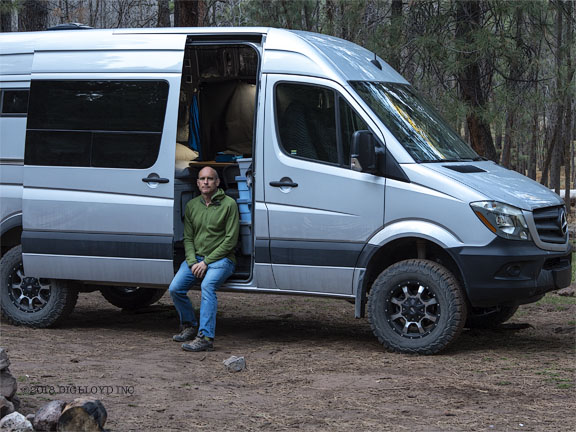
Olympus E-M1 Mark II + OLYMPUS M.45mm F1.2 @ 93.4mm equiv (45mm)
[low-res image for bot]
Update April 7, 22 days after crash, 17 days after ER visit #2
To bed just after 9 PM, sleep eluded me for 2+ hours, which has been a common event. Still, I slept soundly until 7 AM., though I rested in a half-sleep state for an hour or so. Striking to me is the relatively minimal dreaming (at least that I remember), versus the prolonged, varied, and vivid dreams up to 10 days after the crash. Whatever regulation mechanism there is for dreaming, it seems that a concussion loosens up and lubricates whatever mechanism engages/encourages dreaming, even (in my case) nearly all the night right until awakening (through day post-crash day 9, at least). Whether that dreaming is in REM state or not I cannot be sure, but I think so. This I think might be one good clue to the phase of recovery (vivid and prolonged dreaming).
A bonus even with my contact lenses out: parked off the main road on a nice private dirt road, the crickets chirped happily while the stars blazed bright (blurred as they were without contacts!) while a mild breeze yielded pleasant ventilation around 70°F to start, dropping to 52°F at the coldest—quite a wonderfully perfect night and one of those small things to be thankful for. If you have not been outdoors like that, you’re missing something in life that costs nothing, but cheers the heart.
I took a leisurely morning today, stepping out of the van and riding away for a nice 45 minute ride in the Gila National Forest on SR114 with about 2000 vertical feet / 610m of climbing from ~6000 to ~8000 feet elevation. There are many nice smaller roads with near-zero traffic, even on Saturday, and I highly recommend these backroads. SR180 is very nice south of the City of Alpine, NM, as is Arizona SR249 out of Alpine, AZ. The temperature was wonderfully pleasant in the 6000-8000 foot range throughout the area. As with prior days, I felt terrific during and after the ride. My feeling is that if a wholesome activity feels good, it probably means something good.
I felt the need for only a modest short nap that day (30 minutes or so), and that was just rest, not sleep. Maybe the next point speaks to another kind of rest.
After the ride and to early afternoon, I had a magical experience: I felt a sense of joy and contentment, almost uncanny, but very present and very real. This lasted about 3-4 hours and I have no explanation—was it the bike ride along with the perfect conditions and/or was it the flip side of the coin of emotional swings possible with a concussion? I cannot say, but the swing at most was from neutral to high—0 to 10 so to speak, but 0 to 10 to -10. It would be useful to initiate and harness that kind of mental state, and maybe I can learn how, sometime, just as I seem to have learned to make small pains vaporize in short order (see March 29 entry).
The foregoing episode as well as the new skill of pain suppression now makes me wonder if those two things have been latent, and that somehow repairing the injury is in the process making new neural connections, or strengthening latent ones. That is how it seems to me. I might have inadvertently played a part by my attempts each day to consciously rest my mind and to quell my thoughts. Maybe that is meditation of a sort, but I do not know as I have never learned it.
While remaining my own whole, I have watched myself as an observer even as I interact with others, and the world (to use a computer analogy: 2 CPU cores are active at once). I was acutely aware of this simultaneous and parallel operation when I arrived at my father’s place: I observed just how degraded my speed of thought was that evening, a sort of quiet running commentary on my own thoughts and speech. It’s hard to describe perfectly, but there it is. Maybe it is a curious kind of mindfulness (again, something I have no experience with, only a sense of what it might entail).
And so it was a good day through 3 PM or so, but by mid-afternoon I was tiring, having driven up to 9000' elevation and taken a wrong turn on a remote dirt road. The bonus was seeing a herd of bighorn sheep, a herd of elk, and several herds of wild horses. I should have just camped overnight up there, but I wanted to get back to pavement which proved a mistake, as I ran into a corridor of strip-mall like crap for mile after mile near Pinetop Arizona, which kept me driving until sunset. By then (and previous two hours), I was toast; I could feel the fatigue like a lead vest weighing me down. Note to self: drive no more than 4 hours per day, and camp early and rest.

Olympus E-M1 Mark II + Panasonic Leica DG Elmarit 200mm f/2.8 POWER OIS @ 415.1mm equiv (200mm)
[low-res image for bot]
Update April 6, 21 days after crash, 16 days after ER visit #2
Slept soundly again, albeit taking 3+ hours to drop off (9 PM to bed, past midnight sleep). And et when waking at 6 AM, my head was clear and I felt good.
I departed my father’s place around 10:30 AM and went shopping for supplies for the 1500 mile trip back. Same store (Sprouts), similar experience though less pronounced: moderately loud and disparate noises inside the store made me feel spaced out and inattentive, but as with the April 4 episode, this passed quickly after exiting. So there is something to the idea that ambient noise is a serious stressor when recovering from a brain injury at least for me.
How a city dweller or worker in a noisy office could manage this while recovering I don’t know, and it repudiates the idiotic but popular anthill “open workplace” (one big echo chamber for dozens of people) that is so trendy today—seems to me that the level of knowledge about the human mind performance is just about nil when it comes to environmental factors, that is, among the trendy types in Silicon Valley. Moderate or high ambient noise is a stressor to many if not all people, concussion or not, as I recall from reading in a scientific study some time back. My concussion has only brought home to me this already-known fact, but laid bare just how nasty the effects are to an already stressed mind (which in modern times is most of the population).
While driving, I wore my Sony noise canceling headphones while driving—these things are amazing: use the sound optimizer and nearly all the wind noise and road rumble disappears; all I hear is a faint hiss and the random but muted other noises. Take 'em off and OMG: the volume seems incredibly loud—there is quite an auditory onslaught while driving at 70 mph. One test of auditory stress is to focus on an audio book while driving—I found this possible but unenjoyable as it required effort.
The night’s 6 hours of sleep apparently caught up with me: 2 hours and 120 miles into the drive, I felt very sleepy. Thinking I would be 'good' with a 30 minute nap, I lay down, quickly sank into a very pleasant half-dream state, and woke up 3 hours later! I have to say that I love the ability to pull over and rest in my Mercedes Sprinter photography adventure van when needed in my comfortable-as-home bed whenever I like.
Anyone with an SUV who likes to travel as I do should think hard about what is the point of an SUV, when none of them have a fraction of the comfort or convenience, and yet my 4x4 Sprinter offers far superior clearance to virtually all the SUVs on the market. I’ll never even consider an SUV again; what a PITA for travel. I am not talking about a full-on sewage-on-board RV Sprinter, but any empty box Sprinter cargo van with a bed, a big Yeti cooler, storage boxes and a table; see Mercedes Sprinter: Bed Platform, Bike Storage, Layout Design. Since the Sprinter costs about the same as any medium-price SUV, it’s a no-brainer IMO. And the Sprinter promises 250,000 miles or more with its long-lasting diesel engine and minimal electronic yuck.
After 5 days of very positive post-ride feel, I am concluding that exercise (cycling for me) has a strongly positive influence on my concussion recovery. Each and every time I have ridden, any brain fog or feeling of tiredness vaporizes, leaving me feeling energized and refreshed when done. Including being able to listen to an audiobook while driving, which I noted as being unenjoyable prior to riding. Going forward, I am thinking that twice-daily rides (each reduced in duration) might be just the ticket to taking advantage of this finding. My thinking for years now has been that the hugely increased blood flow of vigorous exercise benefits all aspects of health including of course the brain. Now, more than ever, I am not just persuaded but convinced of the validity of that theory. Which science is only now beginning to probe (see March 28 entry for more).
A bonus even with my contact lenses out: parked off the main road on a nice private dirt road, the crickets chirped happily while the stars blazed bright (blurred as they were without contacts!) while a mild breeze yielded pleasant ventilation around 70°F to start, dropping to 52°F at the coldest—quite a wonderfully perfect night and one of those small things to be thankful for. If you have not been outdoors like that, you’re missing something in life that costs nothing, but cheers the heart.
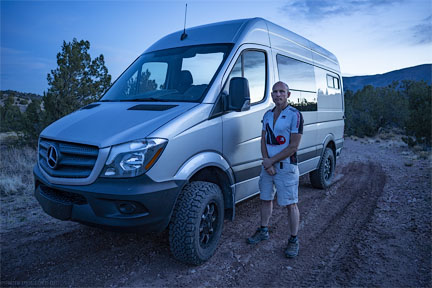
Sony A7R III + Zeiss Loxia 25mm f/2.4 Distagon
[low-res image for bot]
Update April 5, 20 days after crash, 15 days after ER visit #2
4:30 AM: Slept soundly from 9 PM to 4:00 AM, and felt good upon waking, but wish I could have had 3 hours more sleep! Still, as with yesterday’s limited sleep, my head is clear. I am normally an 8-9 hour guy for sleep needs, so 6 or 7 hours leaves me well short of my usual requirements. I don’t know what to do about the sleep issue and I am reluctant to use any sleep aid (ambien or diazepam or similar), as these all work on the brain.
Today I will do an easy ride (yesterday’s was high intensity) and see if I continue to have excellent results on the bike. All evidence to date supports the idea that my brain injury has affected certain aspects of function strongly, but not neuromuscular aspects. Thus cycling is easy, but working at a computer or attending to other cognitive tasks more than 90 minutes is fatiguing. I sense no deficit in analytical processing, only a stamina issue. I would make the analogy of driving to the same place, but as the drive goes on, the hill steepens, and speed drops steadily to 50 mph instead of 75 mph.
Update (late): today was my best day so far: mentally sharp all day, no issues, felt good, almost no headache, still some fatigue but it might just be the 4 AM wakeup this morning. Tomorrow I head towards home (~1400 miles); I intend to limit mileage to at most 250 miles a day and to incorporate a ride and some photographic shooting each day on the way back. I have actually already shot some material but I have held off on the visually and mentally demanding evaluation / processing / publishing phase, which means hours of work at the computer.
I now start to think of the less important but annoying things: weighing in at 176 pounds instead of my scheduled 171 pounds—this matters a ton for double centuries with a lot of climbing.
Ideal for any Mac with Thunderbolt 3
Dual Thunderbolt 3 ports
USB 3 • USB-C
Gigabit Ethernet
5K and 4K display support plus Mini Display Port
Analog sound in/out and Optical sound out
Works on any Mac with Thunderbolt 3
Update April 4, 19 days after crash, 15 days after 2nd ER visit
Went to bed last night at 9 PM but tossed and turned until 1 AM, sleeping not, thought it was restful. And yet in spite of the sleep problem, this morning my head was clear and I felt better today than I had in 3 days.
I now have this working theory that the injury to my brain has (as far as I can tell) left neuromuscular functions unimpaired. I say this because I can detect no loss of power or coordination (smoothness and speed of pedal stroke, bike handling, etc), and that assessment is based on a decade of hard core cycling as well as this year’s extensive training. And yet this co-exists with improving but still impaired cognitive stamina which at its best is perhaps 90 minutes of concentration, a bit less or a bit more, depending. It’s not a dropoff of attention per se (no nodding off) so much as an increasing feel of the need to close my eyes and rest my head, so to speak.
Today was a hard cycling test: 88 minutes at the maximum power I could sustain just short of developing lactic acid “burn” in the muscles, at an altitude of 4000' (I am/was not fully acclimated as yet, which is unusual, but there is partial acclimatization). My lungs were working to their full capacity, and I wore an N100 dust mask due to a pall of airborne brown dust in the Las Cruces, NM area (this kept my lungs clear and no bronchospasms). Result: outstanding power, absolutely no loss of mental attention—I felt great during and after. I have this theory that 80000 miles or riding over a decade have resulted in developing a highly efficient area of my brain tuned for efficiency. My feeling is that the primary mental demands are visual processing of a rapidly changing road surface and environs, with everything else operating semi-autonomously (yet under conscious control).
Today I had a curious “episode” about an hour after the ride, though given how good I felt during and after, I do not associate it with the ride. That is: while in a supermarket with a relatively high noise level, my ability to attend to my surroundings dropped markedly. I found it it challenging to decide which checkout line to choose and being more or less oblivious to my gesturing father urging me towards another checkout line. Stepping outside after checkout, the whole thing rapidly began to clear and disappeared within 2 minutes—I felt the change immediately upon exiting. The only factor I can associate with the episode was a high ambient noise level.
I now have this working theory that high ambient noise levels take a heavy toll on my brain. I have always been very sensitive to noise my whole life (particularly when already stressed by other factors), so a brain injury could very well make high noise an “overload” issue very quickly. This would explain the noisy supermarket episode as well as why the 4-5 hours of driving pushed me back into mental fatigue for two days: at 65-75 mph on mediocre to shamefully bad pavement, there is a constant wind noise plus pavement rumble along with assorted squeaks and rattles—we tend to tune this out, but try attending to the ambient sound while driving on rough pavement; it is quite a high noise level. A Mercedes Sprinter is no heavily sound-damped Porsche or Mercedes sedan! I will be driving the freeway home (1300 miles, taking my time, stopping any time I feel like napping) soon using my Sony noise canceling headphones, which work great. They take out 95% of the ambient noise, which if my theory is correct, should help tremendously.
Update April 3, 18 days after crash
Thanks again to well wishers. I’m eager to get back to work, but today’s blog post over at WindInMyFace.com was enough (an hour), and it did not demand assessing images, which is much more visually demanding, even pre-concussion.
I’m still suffering from the 600 mile drive yesterday; my head is not clear. I slept well last night and napped today, but a good kick in the shins is good for me I guess e.g., a reminder that long days like that should be avoided for some time to come. The thing is, I feel physically very strong, with my legs spoiling for a thrashing (hard workout) which makes it a weird combination of physical impatience while the brain clearly needs more time for cognitive tasks.
I felt great on March 30 and April 1 and nearly so April 2 (and at 6200' elevation), so I find it hard to blame a short bike ride for yesterday and today’s mental “fog”. The driving I think is much more demanding than riding my bike, requiring more mental effort. I guess it drained me (April 2 600 mile drive).
Sleep continues to be problem: I can’t seem to fall asleep until 11:30 PM, which has repercussions for being rested in the morning. Today’s 2 PM nap definitely was the right thing to do.
Today I did a very short (23 minutes) but very high intensity workout: sustained output of nearly 500 watts (that’s a lot) for 30 seconds and several other similar efforts for 1-3 minutes (but at 380 watts or so). That effort seemed to clear my head better than anything all day, so now I have this curious situation in which (maybe) increasing the exercise might somehow clear out the brain fog. TBD with a morning ride tomorrow.
Below, instead of weighing in at my planned 171 pounds, I’m up to 176, not having restricted my calories for 3 weeks. For my first post-concussion ride, I relied upon my sense of well being so I went ahead: it was 90°F with a rough road (I lowered the tire pressure) and a stiff headwind and I put out ~240 watts for 45 minutes and felt great, noticing no ill effects at all even 24 hours later. I was able to spin smoothly in the 98 to 103 rpm range, so clearly the neurophysiological firing is working well for exercise—I could not detect any degraded coordination in that regard.
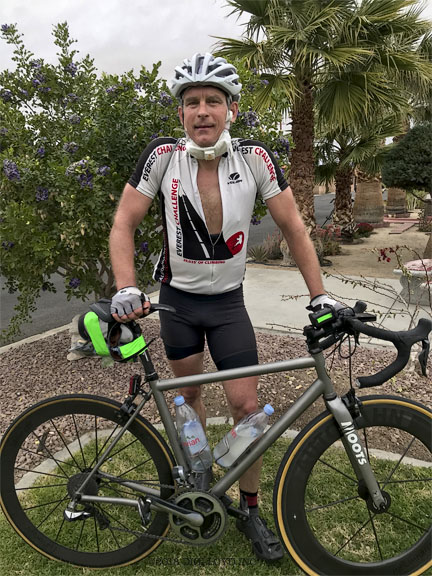
iPhone 7 Plus + iPhone 7 Plus back dual camera 3.99mm f/1.8 @ 28mm equiv (4mm)
[low-res image for bot]
Seagate 22TB IronWolf Pro 7200 rpm SATA III 3.5" Internal NAS HDD (CMR)
SAVE $100



